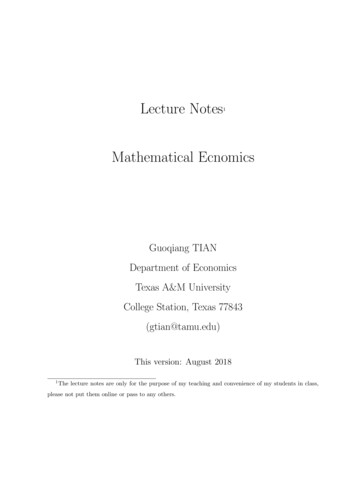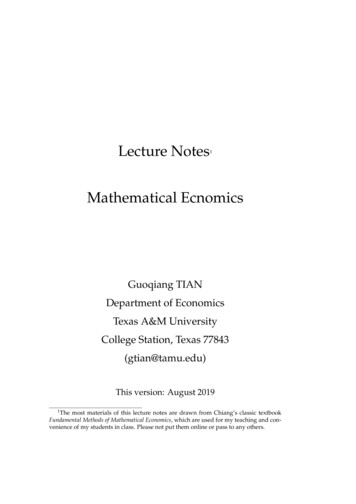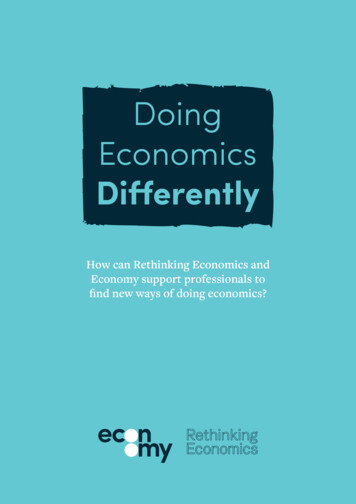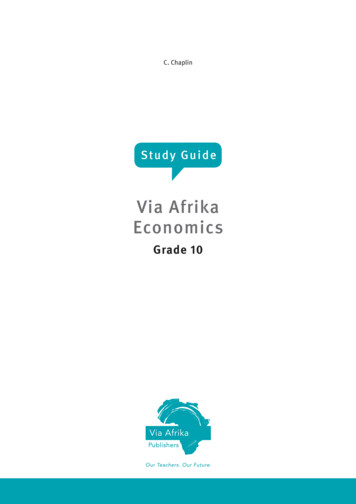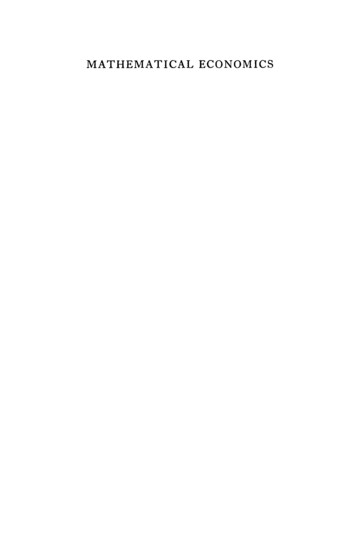
Transcription
MATHEMATICAL ECONOMICS
Some Other ELBS Low-priced EditionsMacmillanMacmillanAllenAllenMACRO-EcONOMIC THEORYMATHEMATICAL ANALYSIS FOR ECONOMISTSAtiyahTHE SALE OF GOODSBlaugECONOMICS OF EDUCATION, VOL.Bridger andde SoissonsFAMINE IN RETREAT?Drover andBosleySHELDON'S PRACTICE AND LAW OF BANKINGHagueMANAGERIAL ECONOMICSHansonA DICTIONARY OF ECONOMICS AND COMMERCEHansonHansonMONETARY THEORY AND PRACTICEA TEXTBOOK OF ECONOMICSHicksVALUE AND CAPITALLipseyAN INTRODUCTION TO POSITIVE ECONOMICSMarshallPRINCIPLES OF ECONOMICSMeadeTHE THEORY OF INTERNATIONAL ECONOMICPOLICY, VOLS. lAND IIPaishBENHAM'S ECONOMICSPrestPUBLIC FINANCE IN DEVELOPING COUNTRIESPrestPUBLIC FINANCE IN THEORY AND PRACTICEPitmanPenguinIDentMacdonald &1EvansLongmanMacdonald &1EvansMacdonald &1 EvansM acdonald &1 EvansOxford University PressRobinsonTHE ACCUMULATION OF CAPITALStaffordMATHEMATICS FOR ECONOMISTSStillweIl,LipseyandClarkeWORKBOOK TO ACCOMPANY 'ANINTRODUCTION TO POSITIVE ECONOMICS'Stonier andHagueA TEXTBOOK OF ECONOMIC THEORYWeidenfield &1NicolsonMacmillanOxfordUniversity PressPitmanWeidenfield &fNicolsonWeidenfield &1NicolsonMacmillanMacdonald &1 EvansWeidenfield &1NicolsonLongman
MATHEMATICALECONOMICSR.G.D.ALLENSecond EditionCfY0@\EENGLISH LANGUAGE BOOK SOCIETYandMMACMILLAN
R. G. D. Allen 1956, 1959All rights reserved. No part of this publication maybe reproduced or transmitted, in any form or by anymeans, without permission.First Edition 1956Reprinted 1957Second Edition 1959Reprinted 1960Reprinted (with alterations) 1963Reprinted 1964, 1965, 1966, 1970, 1972, 1973, 1976ELBS edition first published 1973Reprinted 1976Puhlished byTHE MACMILLAN PRESS LTDLondon and BasingstokeAssociated companies in New York DublinMelbourne Johannesburg and MadrasISBN 978-1-349-81549-4ISBN 978-1-349-81547-0 (eBook)DOI 10.1007/978-1-349-81547-0Also by R. G. D. AllenBASIC MATHEMATICSMACRO-ECONOMIC THEORYMATHEMATICAL ANALYSIS FOR ECONOMISTSTrus book is sold subject to the standard conditions of the Net Book Agreement.The paperback edition of trus book is sold subject to the condition that itshall not, by way of trade or otherwise, be lent, re-sold, hired out, or otherwise circulated without the publisher's prior consent in any form of bindingor cover other than that in wruch it is published and without a similar condition including trus condition being imposed on the subsequent purchaser.
PREFACETHIS book has evolved from three strands of thought. When I was firstinterested in mathematical economics in the early 1930's, it seemed to methat the main need was for a grounding in calculus and I wrote my textbook, Mathematical Analysis/oT Economists (1938), for that purpose. I didnot venture into the higher reaches of algebra and I made no use of thecomplex variable. lieft such matters to be written up by those withspecialist applications to economics in mind. Subsequently the uses ofmatrix algebra, of vectors and complex variables, of operational processesand of other such mathematical devices have been greatly developed inmany parts of mathematical economics. There are in my view no mathematical texts on higher algebra and on operational methods which are reallysuitable for economists.A second development of the last twenty years is the growth of econometrics. This has been so rapid that I think there is some risk that thenecessary development of economic theory, formulated in a way whichmakes econometric sense to a statistician, will lag behind rather seriously.Such formulations of economic theory must be in mathematical terms butsimplified as far as possible.Finally, the change in the direction of economic thought over the pasttwenty years has involved a considerable upheaval in the structure ofeconomic theory. This is partly, though by no means entirely, the resultof the work of Keynes. I believe that there is now areal need for somesynthesis of the " new " economics, for some calm survey of the form andscope of econornic theory.With these things in mind, I feel that the best contribution I can makeis not to extend my 1938 book but rather to write a completely differentone, a text on economic theory written in mathematical terms. The presentwork is not mathematics for the economist, nor is it econometrics.It aims at a fairly systematic treatment of some of the more importantand simpler parts of mathematical economics. My main problem isone of selection from a vast range of economic topics, of making thebook reasonably up-to-date and of keeping it down to reasonable dimensions. Even if I include only what is of particular interest to me personally,I would still find I have too much. To those who look for other topics ordifferent methods of treatment, I can only make the familiar excuses of theanthologist.
VIPREFACEI am sure that the book is very different from what it would have been ifI had written it five years ago. How long it will remain even approximatelyup-to-date I cannot pretend to guess. I feel, however, that many of thetechniques I attempt to describe will be relevant for some time to come ;they are now relatively new and they need to be consolidated and absorbedinto the general body of economic theory. Moreover, my guiding principleis to start with, and to remain as elose as possible to, economic problemsof the real world, simplified as an economist might simplify them, andtranslated into mathematics of no more than moderate difficulty. I hopethat this approach will appeal to many economists now and in the future.I could not write a book of this kind without assistance on a scale farbeyond my powers to acknowledge. I am grateful for the constantencouragement and advice of my colleagues, particularly Professor LionelRobbins, Professor James Meade, Mr. David Knox, and Mr. RalphTurvey. Mr. W. M. Gorman and Dr. F. H. Hahn of the University ofBirmingham have kindly read through the manuscript; they see the needfor a book on the present lines, they are ideally qualified to write it, andyet they stand aside and allow me to monopolise the market. Above all,I am in debt to Dr. Helen Makower, Dr! G. Morton and Dr. A. W.Phillips; this is clear to anyone who reads the middle and later chaptersas now written.R. G.D.ALLENLoNDON SCHOOL OF EcONOMICS
PREFACE TO SECOND EDITIONI am glad to have this opportunity of making some changes in the text.Firstly, I have corrected errors and misprints which escaped me, all toofrequently, during my original proof-reading. Secondly, I have madenumerous revisions in the wording and exposition throughout the text.I hope that these will make the argument more clear and precise.Thirdly, I have included some additional references, mainly to booksand articles published since 1956. It happens that half-a-dozen books ofoutstanding merit have appeared in the two years 1957 and 1958. Theyare Goldberg : IntroductWn to Difference Equations (1958); Murdoch :Linear Algebra JOT Undergraduates (1957); Kemeny, Snell and Thompson :Introduction toFinite Mathematics (1957); Thrall and Tomheim : VectOTSpaces and Matrices (1957); Luce and Raiffa: Games and Decisions(1957); and Dorfman, Samuelson and Solow: Linear Programming andEconomic Analysis (1958). None of these can be described, mathematically, as very simple; they vary in level from the moderately difficultto the quite advanced. But, equally, none of them can be ignored in theeducation of the mathematical economist.Finally, I have complete1y re-written some critical sections: 1.9 and5.8 on time lags in dynamic models; 2.3, 10.3, 17.1 and 17.9 on generaleconomic equilibrium; and 16.2 on the dual problem in linear programming. Substantial parts of the chapters on vectors and matrices have beendrastically re-cast. I have extended Appendix A which deals with the" practical " mathematics of operators and linear systems. I have addeda complete1y new Appendix B on "modem" algebra to serve as anintroduction to the rigorous and postulational development of algebra.In asense, this is a complement to Appendix A. The strict, axiomaticapproach of the modem algebraist should be of considerable interest initself to the economic theorist concemed with model-building. In anycase, I hope that the new Appendix provides an under-pinning for thealgebra of the text, where a compromise is adopted in the interests ofsimplicity.My thanks are due to a number of correspondents. I am particularlygrateful for the suggestions made by Sven Dan" of the University ofCopenhagen; by Lucien Foldes of the London School of lconomics;
viiiPREFACEby Maurice McManus of the U niversity of Birmingham and the School ofBusiness Administration, Minnesota; by Peter Newrnan of the UniversityCollege of the West Indies; and by Ciro Tognetti of Centro per laRicorca Economica ed Econometrica, Genoa.R. G. p. ALLENUNIVERSITY OF CALIFORNIA, BERKELEY]ANUARY, 1959
CONTENTSPAGECHAPTI!RPREFACEPREFACE TO SECOND EDITIONvüINTRODUCTIONxv1.THE COBWEB AND OTHER SIMPLE DYNAMIC acro-economic Variables and RelationsA Formulation of Keynesian Liquidity PreferenceGeneral Equilibrium: Modigliani ModelADynamie Monetary ModelMacro-economic Models in "Real" TermsThe Static MultiplierADynamie Multiplier ModelThe Relation between Saving and InvestmentMarkets for Goods and Factors313438404245485355THE ACCELERATION PRINCIPLE3.13.23.33.43.53.63.73.83.94.NotationThe Cobweb ModelA Simple Continuous ModelGeneral Features of the ModelsThe Econometric ProblemExtensions of the Cobweb ModelModels with StocksStability of Market EquilibriumTime Lags in Dynamic ModelsKEYNES AND THE CLASSICS: THE MULTIPLIER2.12.22.32.42.52.62.72.82.93.VAutonomous and Induced InvestmentThe AcceleratorHarrod-Domar Growth TheoryPhillips' Model of the MultiplierPhillips' Model of the Multiplier-AcceleratorHarrod-Domar Growth Theory in Period FormSamuelson-Hicks Model of the Multiplier-AcceleratorThe Possibility of Progressive EquilibriumDistributed Investment; Period and Continuous Analysis606264697274798386MATHEMATICAL ANALYSIS: COMPLEX NUMBERS4.14.24.34.44.54.64.7The Description of OscillationsTrigonometrie FunctionsVectors and Complex NumbersPolar and Exponential Forms of Complex NumbersThe Algebra of Complex NumbersPolynomials and EquationsSinusoidal Functions and Oscillatory Motion919297103106111116
CONTENTSCHAPTI!R4.8 Vector Components of a Sinusoidal Function4.9 Derivatives, Integrals and Combinations of Sinusoidal Variables5.PAGR122125MATHEMATICAL ANALYSIS: LINEAR DIFFERENTIAL EQUATIONS5.15.25.35.45.55.65.75.85.96.MATHEMATICAL ANALYSIS:6.16.26.36.46.56.66.76.87.Differential EquationsBasic Results; Initial Conditions and Arbitrary ConstantsLinear Differential Equations: First OrderLinear Differential Equations: Second OrderLinear Differential Equations GenerallyThe Laplace TransformSolution of Differential Equations by Laplace TransformsContinuously Distributed (Exponential) LagsThe Use of p a. iw176179183187192196201206TRADE CYCLE THEORY: AnE CYCLE THEORY: GOODWIN, KALECKI AND PHILLIPS8.18.28.38.48.58.68.78.88.99.170LINEAR DIFFERENCE EQUATIONSDifference EquationsDiscrete Solution; Basic ResultsLinear Difference Equations: First OrderLinear Diffetence Equations: Second OrderLinear Difference Equations Genera1lyEconomic IllustrationsDelays, Distributed Lags and the MultipIier-AcceleratorContinuous Solutions of Difference Equations7.1 The Simple MultipIier-Accelerator Model withInvestment7.2 Detailed Solution of the Simple Model7.3 Interpretation of the Solution7.4 AppIication in Trade Cycle Theory7.5 Inventory Cycles7.6 Oscillations in Autonomous Investment7.7 A More General Model with Distributed Investment7.8 Analysis for Humped Investment7.9 Analysis for Distributed odwin Model: Simple VersionExtensions of the Goodwin ModelKaleclri Model: Early VersionSolution of the Difference-Differential EquationKalecki Model: Later VersionPhillips Model: Econornic RegulationStabilisation PolicySorne Illustrations of StabiIisation Policies240242247251254259262268273ECONOMIC REGULATION: CLOSED-Loop CONTROL SYSTEMS9.1 A Schematic Representation9.2 Sorne Econornic Models in Schematic Form9.3 Response to Sinusoidal Input in a Linear Model281284289
CONTENTScI;IAPTER9.49.59.69.79.8The Feed-back Transfer FunctionFree Variations in a Linear Closed-loop SystemThe Engineer's Approach: Linear and Non-linear SystemaRegulation in Closed-loop SystemsEconomic Stabilisation Policy10. GENERAL10.110.210.310.410.510.610.710.811.EcONOMIC EQUILIBRIUMEquilibrium of ExchangeEquilibrium with Fixed Production CoefficientsGeneral Market EquilibriumCounting EquationsStability of Market EquilibriumSome Problems of Comparative StaticsProductionFunctionsThe Production Function as a Matrix314317320323325329332337The Analysis of Industries by Inputs and OutputsThe Transactions MatrixLeontief's Open SystemTransactions in Money ValuesThe Matrix of Input CoefficientsSolution for Three IndustriesThe Walras-Leontief Closed SystemLeontief's Dynamic SystemDynamic Solution far Two inear Equations and TransformationsVectorsThe Algebra of VectorsLinear Combinations of Vectors; Convex SetsMatricesVectors and MatricesThe X Notation; Inner HEMATICAL ANALYSIS: MATRIX 98'303305308MATHEMATICAL ANALYSIS: VECTORS AND BINTER-INDUSTRY RELATIONS11.111.211.311.411.511.611. 711.811.912.nIntroduction; the Basic Rules of AlgebrsIllustrations of Operations with MatricesEqualities, Inequalities, Addition and Scalar ProductsMultiplication of MatricesTranspose of a MatrixMultiplication of Vectors and MatricesInverse of a Square Matrix; Determinant ValuesEquivalence and Rank of MatricesSquare Matrices.403408411414422424429435440APPLICATIONS OF VECTOR AND MATRIX ALGEBRA14.1 Linear Combination and Dependence14.2 Linear Equations and their Solution448453
Linear TransformationsCharacteristic Equation of a Square MatrixQuadratic FormsStability of Market EquilibriumLeontief's Static SystemTransactions MatricesLeontief's Dynamic SystemELEMENTARY THEORY 3530PROGRAMMINGA Simple Example of Linear ProgrammingSimple Example: Dual ProblemReduction to the Solution of aGameA General Linear Programme.and its DualEquivalence of General Linear Programmes and Two-PersonZero-Sum GamesLinear Programmes arranged for ComputationSome Properties of Convex SetsThe Simplex Method of SolutionSolution of a Simple Linear Programme by Simplex Method535539541545546549553556559PROGRAMMING OF ACTIVITIES : ALLOCATION OF 1467472480483485489GAMESEconomic Applications of the Theory of GamesThe Two-Person Zero-Sum Game and its Pay-off MatrixExpectation of the Game; Pure and Mixed StrategiesMinimax, Saddle Points and Solutions of GamesSolution for a 2 x 2 Pay-off MatrixGraphical Solution for a 2 x n Pay-off MatrixThe General Case of a Two-Person Zero-Sum GameSolutions of Particular GamesIllustrations16. LINEARPAGEIntroduction: General Economic EquilibriumActivity Analysis: Concepts and DefinitionsLeontief's Open System as Linear Programming of ActivitiesSubstitution in Leontief's Open SystemRepresentation of Technical PossibilitiesEfficient Allocation : No Limitation on Primary FactorsPrices and the Dual ProblemEfficient Allocation : Limitations on Primary FactorsProgrammes over Time; von Neumann Growth Model565568571573577586591595600THE THEORY OF THE FIRM18.118.218.318.418.518.618.718.818.9Marginal Analysis: Substitution of Factors in ProductionJoint ProductionMarginal Analysis v. Linear Prograrnming of the FirmThe Technology of the FirmTwo Illustrative Linear ProgrammesLinear Programme: Fixed Factors and Given Product PricesThe Ricardo EffectLinear Programme: Fixed Demand ProportionsAn Example of Specialisation608613618621625633638643649
CONTENTSCHAPTER19. THE THEORY OF VALUE19.119.219.319.419.519.619.719.8Utility: the Ordinal ViewConsumer's DemandThe Income and Substitution EffectsDiagrammatic RepresentationMeasurability of UtilityConsumption Activities and Linear ProgrammingA Linear Programme of Technology-TastesSome IllustrationsxiliPAGB65465866066566967668068520. THE AGGREGATION PROBLEM20.120.220.320.420.520.620.720.8The ProblemSimple Example: Aggregation over IndividualsSimple Example: Aggregation over CommoditiesContradictions between Micro- and Macro-RelationsExtension of the Simple ExamplesSummation over Individuals and over CommoditiesGeneral Case: One Macro-RelationWelfare Economics694697701704710712716720APPENDIX A: THE ALGEBRA OF OPERATORS AND LINEAR SYSTEMS1. Operational Methods2. The Operators D and [)-l3. Some Results for D4. Solution of a Differential Equation5. The Operators E and E-l6. The Operator LI7. Solution of a Difference Equation8. Linear Equations and Transformations9. Linear Models725725727730732733734736738APPENDIX B: THE ALGEBRA OF SETS, GROUPS AND VECTOR SPACES1. The Concepts of Modern Algebra2. Sets and Boolean Algebra3. Relations: Functions, Mappings and Transformations4. Equivalence: Homomorphism and Isomorphism5. Binary and Other Operations6. Groups7. Fields and Rings8. Vector Spaces9. Matrices and Linear Transformations10. NDEXC:EXERCISES: SOLUTIONS AND HINTS781805
INTRODUCTIONWHETHER mathematical techniques can be, or should be, used in economicsis a much-discussed question. The proof of the pudding is in the eating.The economist must be left to determine for hirnself, when he reads thefollowing chapters, whether the exposition of some important economictheories in mathematical terms assists hirn in appreciating the theoriesand in working out their implications.The object of the text is to give a summary, and to some extent asynthesis, of what mathematical economists have written on certaineconomic theories. It is introductory, but it is not elementary. It isdirected to the economist rather than to the mathematician, but it assurnessome little mathematical background.The order in which the economic material is developed may seem unusual; it is not the traditional approach. The aim is to treat in mathematical form those economic problems which students of economics arerequired to handle and which have some bearing on the facts of economiclife. It is also to start with something quite simple and to proceed later tothe more difficult. The simplicity of what can be loosely described asmacro-dynamic economics, the starting point here, lies in the fact thatonly a few broad aggregates are considered; the relation to real problemsappears through the dynamic approach. The problems of decision-taking,by the consumer, the firm, or the " economic planner ", involve wholesets of variables and they are best reserved for later treatment.Nor is the order that of increasing complexity of the mathematics. Thisis an economic, not a mathematical, text-book. The nature of the mathematical techniques used is rarely allowed to dictate the order of development. The kind of mathematics set out in Allen (1938) and Tintner (1954)is assumed throughout, that is a good deal of calculus and some algebraand geometry. The main concession is that time out is taken at convenientplaces to introduce more advanced mathematical techniques, at the cost ofdisturbing the flow of the economic development.Further, this is a book on economic theory, not on applied economicsor econometrics. It is inevitable that the development verges at times onthe econometric, since the concentration is always on economic theorieswith some relation to actual problems. Some attempt is made to frameeconomic theories in such a way that they can be tested against empirical
xviINTRODUCTIONdata, though by no means always sufficiendy for the statistician to go towork. Indeed, some of the eeonomic analyses presented here wereoriginally designed by their authors for immediate eeonometrie applieation; this is the ease for the work of Leontief (1951, 1953) and Koopmans(1951), and perhaps also for the trade eyde theories of Hieks (1950). Butthe models treated here are eompletely deterministic; eeonometrie workgenerally requires that stochastic elements are induded in the models.Within the general field so demareated, the method of treatment isstraight-forward enough. The elements of maero-dynamic eeonomietheory (Chapters 1, 2 and 3) show up the need for using differential anddifference equations and for the deseription of oseillatory variation bymeans of complex variables and veetors (Chapters 4, 5 and 6). On thisbasis ean be developed some fairly elaborate trade eyde theories, leadingto the vital problems of economie regulation (Chapters 7,8 and 9). Generalequilibrium analysis, both of the Walrasian and of the Leontief (inputoutput) types, is then taken up (Chapters 10 and 11). It is found that agood deal of veetor and matrix algebra is needed (Chapters 12, 13 and 14)and that the theory of games is of relevanee to eeonomie problems (Chapter15). The development of linear programming and decision-taking eanthen proceed (Chapters 16 and 17) with particular applieations to thetheory of the firm and of the eonsumer (Chapters 18 and 19). Theeoncluding chapter takes up some problems in aggregation and theeeonomics of welfare (Chapter 20).It is evident in these ehapters how mueh is drawn from the work of alimited number of economists of Anglo-Ameriean sehools, from Hieksand Samuelson, Hansen and Harrod, Leontief and Koopmans, and (amongthe younger writers) from Barna, Baumol, Domar, Dorfman, Duesenberry,Goodwin, Klein, Makower, Morton, Phillips, Solowand Turvey. Thisis an expression of indebtedness, not of apology. For it is the work of theseeeonomists that is familiar to the present author; and it is the work whiehwill be in the minds of most readers of this text. Only the tide of the bookmay be questioned, sinee these ehapters are eoneerned, not so much withmathematical economies in general, but with eertain economie theories ofpresent interest, developed in mathematical terms by Anglo-Americaneconomists.The ehapters also give the impression of a very limited range of eeonomictheories. There is litde or nothing on expectations, or on internationaltrade or sector analysis generally. Further reflection may show that thetopics treated here, though limited in scope, are of central importance inthe general body of economic doctrine. Other topies, dealing with expecta-
INTRODUCTIONxvutions or international economics, can be developed from them. Moreover,the analyses both of the trade cyc1e and economic regulation (Chapters 7,8 and 9), and of linear programming and decision-taking (Chapters 16, 17,18 and 19), are largely a product of work done in the decade after theSecond World War. They are coming to hold the centre of the stage ineconomic theory and all economists need to know at least what they aretrying to achieve.In conclusion, it must be stressed that mathematical economics is appliedmathematics, a partnership between mathematics and economics. Resultsin mathematical economics of any interest can only be derived by aneconomist using mathematics. The same is true of other fields of appliedmathematics such as engineering; indeed, the economist can learn a gooddeal from the engineer both as regards the kind of mathematics to use andin the formulation of the technical problems.There is a good deal of misunderstanding of the nature of mathematicsand of its mode of application. Pure mathematics is sometimes describedas a "language", with the implication that it is easily translated intoEnglish. It is nothing of the kind; rather it is a specialised form of logic,of reasoning. A mathematical proof may be quite incapable of " translation ", though the premises from which it starts and the consequencesreached can be, .and should be, put in " literary " form.Further, the concentration in mathematical teaching on " proofs ", on" Q.E.D." at the bottom of the page, tends to suggest that pure mathematics proves theories. It does nothing of the kind; it simply arguesfrom premises to conc1usions and the premises may be any self-consistentset ofaxioms which anyone cares to propose. Theories only arise in aparticular subject matter, whether economics or electrical engineering,and so in applied mathematics. The theories then involve clothing thepremises with a certain " real life " garb and in interpreting the logicalormathematical consequences in the same way. It can be said, if no slip ismade in the reasoning, that the consequences hold if the premises arevalid. But this is not a proof of any theory in economics or any other field.Theories are to be tested against facts, either the premises or (moreusually) the consequences. The testing of a theory can lead to its rejectionas inconsistent with facts; but it can never lead to the " proof" of thetheory, but only to its provisional acceptance as not inconsistent with facts.Mathematical economics is best regarded, therefore, as the process offollowing up the consequences of a particular set of self-consistent axiomswith econo nic content. The proof is the establishment of the consequencesof the axioms, not of the validity of the theory.
xviüINTRODUCTIONIf mathematics is no more than a form of logical reasoning, the questionmay be asked: why use mathematics, which few understand, instead oflogic which is intelligible to all? It is only a matter of efficiency, as whena contractor decides to use mechanical earth-moving equipment ratherthan picks and shovels. It is often simpler to use pick and shovel, andalways conceivable that they will do any job; but equally the steamshovel is often the economic proposition. Mathematics is the steam shovelof logical argument; it may or it may not be profitable to use it. Thepoint is that economic facts are extraordinarily complicated so that thesteam shovel of mathematics is to be expected to be the most efficient wayof delving into them. To maximise the relation of theory to fact, to minimise the simplification away from reality, it is usually safer to operate inmathematical terms. An economist who ventures to set up a theoreticalmodel of empirical content is weIl advised to do so in explicit mathematical form. He risks failure if he does not; or, at least, he is liable tooverlook some cases or possibilities which may be important, and to makeempirical testing of his model more difficult.REFERENCESAllais (M.) (19ß4),: , . L'Utilisation de l'Outil Mathematique en Economique",Econometrica, 22, 58-71.Allen (R. G. D.) (1938): Mathematical Analysisfor Economists (Macmillan, 1938).Herstein (I. N.) (1953): . Some Mathematical Methods and Techniques inEcononllcs ", Quarterly Journal of Applied Mathematics, 6, 249-62.Hicks (J. R.) (1950): A Contribution to the Theory of the Trade Cycle (Oxford,1950).Koopmans (T. C.) (1951): Activity Analysis of Production and Allocation (Wiley,1951).Leontief (W. W.) (1951): The Structure of American Economy, 1919-39 (Oxford,Second Ed. 1951).Leontief (W. W.) (Editor) (1953): Studies in the Structure of the American Economy(Oxford, 1953).Leontief (W. W.) (1954): . Mathematics in Economics ", Bulletin of the AmericanMathematical Society, 60, 215-33.Samuelson (P. A.) (1947): Foundations of Economic Analysis (Harvard, 1947).Samuelson (P. A.) (1952): . Econonllc Theory and Mathematics-An Appraisal "American Economic Review, 42, 56-66.Samuelson (P. A.) and others (1954): . Mathematics in Economics ", Revinu ofEconomies and Statistics, 36, 359-86.Stigler (G. J.) (1949): . The Mathematical Method in Economics" in Five'. Lectures on Economic Problems (Longmans, 1949).Tmtner (G.) (1954): Mathematics and Statisticsfor Economists (Constable, 1954).Note: In a reference to an article in a Journal, the figure in bold type representsthe volume number, and the following figures the pages of the article.
a dictionary of economics and commerce macdonald &1 monetary theory and practice a textbook of economics evans macdonald &1 evans m acdonald &1 evans value and capital oxford university press an introduction to positive economics principles of economics the theory of international economic policy, vols. land ii benham's economics

